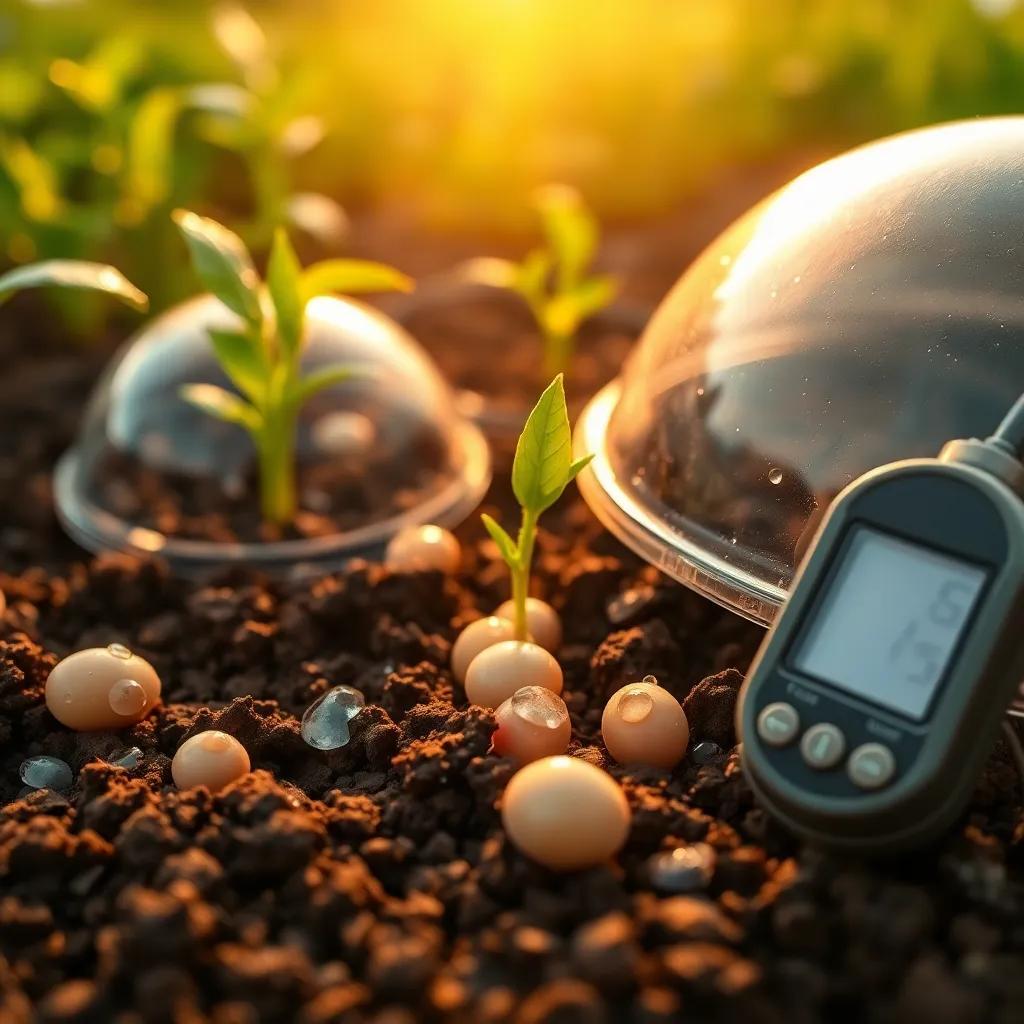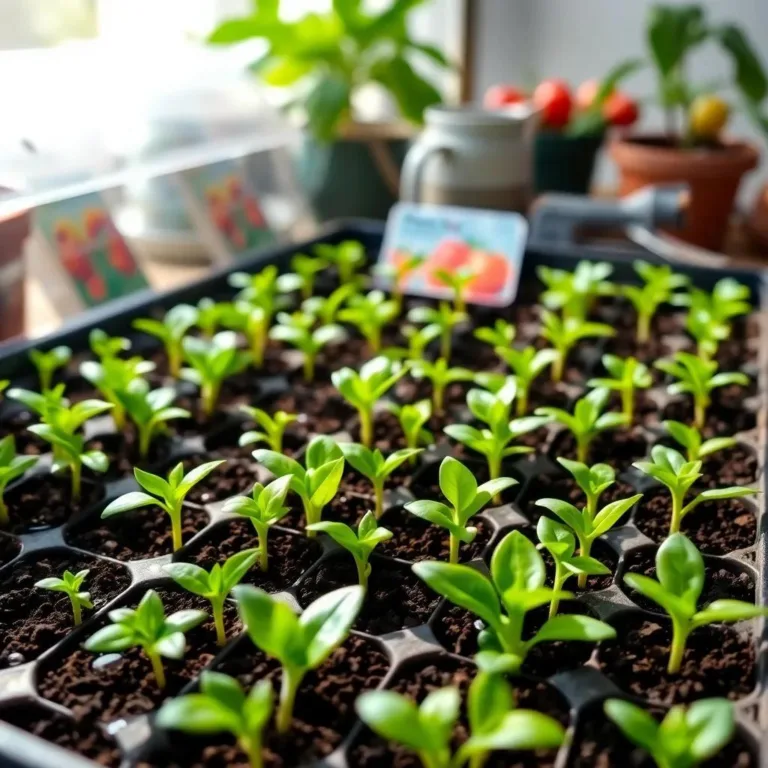Are you ready to grow your own delicious bell peppers? It’s easier than you think! In this guide, I’ll share all the tips and tricks for getting those seeds to sprout and flourish, so you can enjoy fresh, homegrown peppers in your kitchen. Let’s dig in and watch magic happen in your garden!
Factors Influencing Bell Pepper Germination Time
Growing bell peppers can be an exciting adventure! But before those little seeds sprout into vibrant plants, a few factors can affect how long it takes for them to germinate. Let’s explore these factors together!
- Temperature: Bell peppers are warm-season plants and love warmth. The best temperature range for germination is between 70°F and 90°F (21°C and 32°C). If the soil is too cool, your seeds may take longer to germinate. So, keep them cozy! Think of them like me snuggling up with a warm blanket on a chilly night!
- Moisture: Just like I need a drink of water after playing outside, bell pepper seeds need moisture to wake up. Keeping the soil consistently moist but not soaked is key! Too much water can lead to rot, while too little can dry them out. A light misting with a spray bottle works well!
- Soil Quality: The seeds need a happy home! Using well-draining, fertile soil rich in nutrients makes a huge difference. I love to mix in a bit of compost to give my plants a real treat!
- Seed Quality: Fresh seeds are like freshly baked cookies—100% better! Using good quality, disease-free seeds can speed up germination. If your seeds are old or not stored properly, they might just take their sweet time to sprout.
- Light: Surprisingly, bell pepper seeds don’t need light to germinate! However, once they break through the soil, they will need plenty of sunlight to grow strong. You can place them by a sunny window or use grow lights to help them shine!
Understanding these factors can help you create the perfect environment for your bell peppers. With a little care and attention, you’ll be on your way to a thriving garden before you know it!
Ideal Conditions for Germinating Bell Peppers
Setting the stage for your bell peppers is super important! Think of it as preparing for a fantastic party: you want everything to be just right so your guests (or in this case, your seeds) feel welcomed. Here’s what to do!
- Perfect Temperature: Aim for a cozy soil temperature between 75°F and 85°F (24°C and 29°C). If you can, use a seedling heat mat to keep the soil warm and toasty. It’s like giving your seeds their personal heating pad!
- Moisture Matters: Water before you plant! Make sure the soil is damp, but don’t drown it. After sowing the seeds, lightly mist the surface regularly. Keeping that moisture in check will help your seeds wake up and say, “Hello, world!”
- Light It Up: While seeds don’t need light to germinate, your little seedlings will! Once they pop up, give them 12-14 hours of light daily. Sunlight is like nature’s caffeine for them!
- Air Circulation: Fresh air is another key. A small fan blowing gently can help prevent mold and keep the air fresh around your seedlings. Who wouldn’t appreciate a nice breeze now and then?
- Seed Depth: Plant those seeds at a depth of about 1/4 to 1/2 inch (6-12 mm). This depth allows the seeds to stay moist while still getting the oxygen they need. A little pressure on the soil can help them feel right at home.
By creating these ideal conditions, you’re setting your bell peppers up for success! With just a bit of effort, you’ll see those seeds sprouting and ready to grow into delicious peppers! Happy gardening!

Step-by-Step Guide to Germinating Bell Peppers
Getting bell pepper seeds to sprout is like following a recipe for a delicious dish! Here’s my simple, step-by-step guide to help you through the process. Let’s get started!
- Gather Your Supplies: You’ll need high-quality bell pepper seeds, seed trays or pots, a well-draining seed-starting mix, and a spray bottle for watering. Make sure everything is clean and ready to go!
- Prepare the Soil: Fill your containers with the seed-starting mix. This soil should be light and fluffy to give your little roots room to grow. Moisten the soil lightly, but don’t make it a mud pit!
- Sow the Seeds: Make small holes in the soil, about 1/4 to 1/2 inch deep. Place one or two seeds in each hole, then gently cover them with soil. Give the soil a light press to keep those seeds cozy!
- Watering: Using your spray bottle, lightly mist the soil. You want it to be moist, not soaked! Keep an eye on the moisture level, and water as needed.
- Provide Warmth: Find a warm spot for your seedlings. Aim for temperatures between 75°F and 85°F (24°C and 29°C). A heat mat works wonders to keep them snug!
- Light Exposure: Once your seeds sprout, they’ll need plenty of light. Place them near a sunny window or use grow lights for 12-14 hours of light daily.
- Wait Patiently: This is the hard part! You’ll generally see those little green sprouts in about 7 to 14 days. Keep up the care with moisture and warmth!
Following this guide will help you nurture your bell peppers from tiny seeds to strong, healthy plants. Just remember, gardening is a journey, and I can’t wait for you to see your results!
Common Issues During Bell Pepper Germination
Sometimes, the road to growing bell peppers can be bumpy! Don’t worry—most problems can be solved with a little attention and care. Here are some common hiccups you might encounter and how to troubleshoot them!
- Poor Germination Rates: If your seeds are taking longer than expected to sprout, check if they’re fresh. Old or low-quality seeds can lead to low germination rates. Always buy seeds from reliable sources!
- Fungal Diseases: Overly wet soil can lead to nasty fungal infections like damping-off. To avoid this, make sure your soil is damp, not soaked. Good air circulation is also important—don’t hesitate to use a small fan!
- Leggy Seedlings: If your seedlings are looking tall and spindly, it’s a sign they’re not getting enough light. Move them closer to a window or increase the time under grow lights. Strong light helps them grow sturdy!
- Lack of Germination: If your seeds haven’t sprouted after 21 days, it might be time to reassess your conditions. Check moisture, temperature, and seed quality again. It might be time for a new batch of seeds!
- Pests: Sometimes, little critters like aphids or spider mites can sneak in and cause trouble. Keep an eye on your seedlings and use organic insecticidal soap if you spot any pests. Better safe than sorry!
By staying alert and responsive, you can tackle these issues head-on. Remember, every gardener faces challenges, so don’t be discouraged! Your bell peppers will thrive with a little patience and care.
Tips to Accelerate Bell Pepper Germination
Ready to see those bell pepper seeds sprout faster? Here are some helpful tips I’ve gathered to speed up the germination process without compromising the health of your seeds!
- Pre-soak Your Seeds: Soaking your bell pepper seeds in warm water for about 2-4 hours before planting can help soften the seed coat. This little trick can jump-start the germination process!
- Provide Bottom Heat: If you can, use a seedling heat mat! This helps maintain warm temperatures at the root level, promoting quicker germination. Who doesn’t love a warm bed?
- Use a Germination Dome: Cover your seed trays with a clear plastic dome or plastic wrap. This creates a cozy mini greenhouse effect, keeping moisture in and temperature up. It’s like giving your seeds a nice warm hug!
- Optimize Moisture Levels: Check the soil often to keep it just right—damp but not soggy. A light misting daily will do wonders! Consistent moisture can help your seeds sprout quicker.
- Scarification: If you’re feeling adventurous, you can try scarifying your seeds! Gently nicking or sanding the seed coat helps water soak in faster, leading to quicker germination.
By following these tips, you’ll be on your way to faster and more successful bell pepper germination. Just remember, gardening takes patience, but the joy of seeing those seeds sprout makes it all worth it! Happy gardening!

